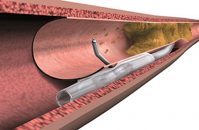Advanced stages of peripheral artery disease cause significant limitations in patients, such as critical limb ischemia (CLI), which manifests with resting pain and gangrene or ulcers of difficult resolution. Uncontrolled progression of this pathology might lead to major amputation, reduced life expectancy and increased healthcare costs. Prior research on infrapopliteal territory have shown contradicting results.…
Long-term Results of Coronary Bifurcation Lesion Treatment in Diabetic Patients
The effects of diabetes on patients with coronary artery disease are well-known, and their outcomes after angioplasty are less favorable, with a higher rate of restenosis, recurrent acute myocardial infarction, and stent thrombosis. Despite advances in drug-eluting stents and procedural techniques, the treatment of coronary bifurcation lesions in diabetic patients shows less positive clinical outcomes…
Use of IVUS in Complex PCI: Results according to Operator Experience
The use of ultravascular ultrasound (IVUS) to guide coronary angioplasty procedures (PCI) has been shown to reduce the risk of major adverse events in numerous randomized controlled studies, registries and meta-analysis. The current guidelines recommend the use of IVUS in left main disease and complex lesions. The proportion of complex PCI procedures has increased over…
Dissection and Re-Entry Technique in Chronic Total Occlusions: Data from the PROGRESS-CTO Registry
The antegrade dissection and re-entry (ADR) technique is considered essential for the management of chronic total occlusions (CTO). It serves as the primary option in some protocols for complex and extensive lesions or as a backup strategy in case of failure with other initial strategies. Dissection techniques include guided methods such as scratch and go,…
Retrograde Approach to Chronic Total Occlusions: Techniques and Outcomes According to the PROGRESS-CTO Registry
The retrograde approach for recanalizing chronic total occlusions (CTO) has undergone significant evolution since its introduction in 1990, improving both in terms of techniques and specialized materials. The increased skill applied to this strategy has resulted in increased success rates for the treatment of CTO in sites with an adequate volume of procedures. Given the…
Outcomes of the Use of Drug Coated Balloons in the Treatment of De Novo Coronary Lesions
Drug coated balloon (DCB) angioplasty offers a novel strategy for treating coronary artery disease. Studies assessing this strategy have shown clinical outcomes comparable to drug-eluting stents’ (DES) in patients with in-stent restenosis and de novo disease in small vessels. However, evidence for the use of DCB in large coronary vessels is limited. This observational, retrospective study DCB…
iFR Guided PCI to the LAD: Same as for non-LAD Vessels?
iFR has been validated as a useful tool for intermediate lesion analysis, with the advantage of not requiring the use of drugs. On the other hand, its use for PCI outcome assessment has not yet been thoroughly looked into, even though there have been promising data. 24% of DEFINE PCI cases presented ≤0.89 iFR with…
Revascularization vs. Deferral of Physiologically Significant Lesions in the Left Main Coronary Artery
Most randomized studies on decision-making in coronary artery disease revascularization exclude left main coronary artery disease (LMCAD), as did the ISCHEMIA Study. On the other hand, the benefits of functionally assessing lesions, proven in studies such as FAME, emphasize the importance of this tool in guiding revascularization decisions. However, there is still little understanding of…
ROTACUT Study: Rotational Atherectomy with Cutting Balloon for Stent Expansion Optimization
Approximately 30% of patients undergoing percutaneous coronary intervention (PCI) present moderate to severe calcified lesions, which presents a significant challenge involving a high incidence of major adverse cardiovascular events (MACE). Rotational atherectomy (RA) is used to modify these calcified lesions and facilitate balloon angioplasty followed by stent implantation. The combination of RA with other plaque…
Drug-Coated Balloons (DCB): Sirolimus vs. Paclitaxel in De Novo Lesions in Small Vessels
The use of drug-coated balloons (DCB) offers the advantage of avoiding permanent stent implants, thus reducing the incidence of in-stent restenosis (ISR), neoatherosclerosis, and late in-stent thrombosis. Additionally, the use of DCB reduces the duration of dual antiplatelet therapy. Current evidence supports the use of DCB for ISR treatment (Class I) compared with drug-eluting stents…
Is Coronary Lithotripsy as Effective as Rotational Atherectomy?
Severely calcified lesions currently pose a significant challenge, as they require adequate preparation through non-compliant balloons or cutting balloons to achieve effective stent expansion. Another option is the use of orbital or rotational atherectomy (RA), but this carries the risk of complications such as slow/no reflow, perforations, dissections, peri-procedural infarction, or guidewire rupture. Despite the…









